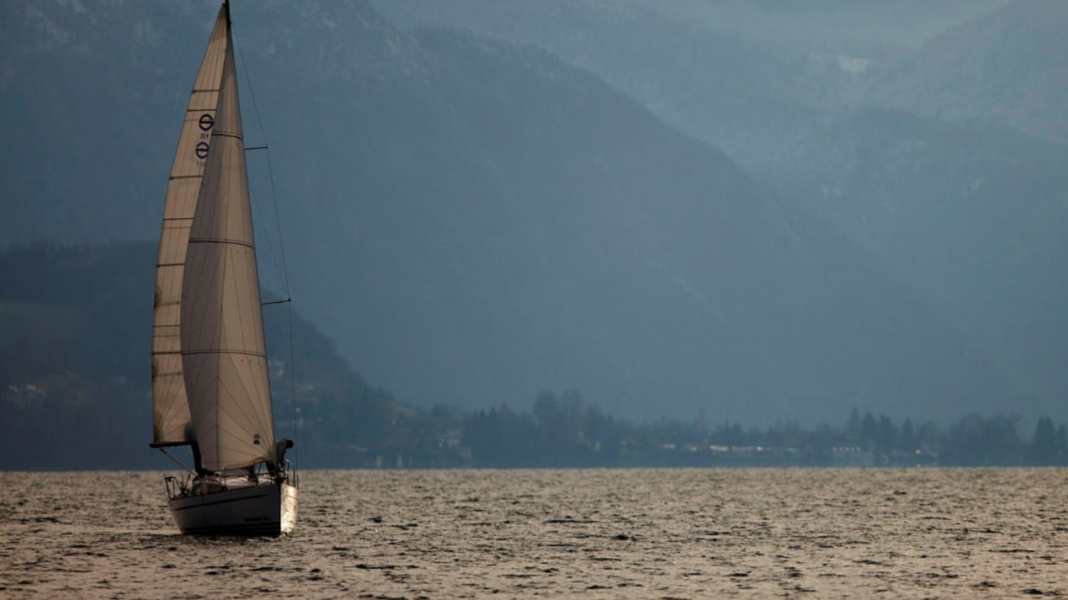
The man had set off in his boat from the village of Attersee on the western shore of Lake Attersee at around nine o'clock in the morning. As he set course for the opposite municipal area of Weyregg, the back railing came loose for unknown reasons. The sailor then fell backwards into the water while his boat sailed on without a rudder. This was reported by the Upper Austrian police.
At the time of the accident, an easterly wind was blowing with gusts of up to twelve knots; the air temperature was 17 degrees and the water temperature around 18 degrees Celsius.
Lucky rescue at the last minute
The rescue was a lucky coincidence: a 30-year-old sailor from Linz and his partner discovered the man in distress at sea, who was now severely hypothermic and already suffering from cramps. The couple pulled the 63-year-old out of the water and saved him from drowning. After first aid, the casualty was flown by emergency helicopter to the Salzkammergut Hospital in Vöcklabruck.
Weyregg am Attersee Water Rescue reported on Facebook that the original alert for a "boat rescue" had turned into a personal rescue.
The treacherous danger of hypothermia
The incident shows how important it is to wear good sailing clothing and a lifejacket to prevent fainting, even when water temperatures are still not too low in many places. While the waistcoat prevents a person who has fallen into the water from drowning, the clothing prevents the body from cooling down too quickly. This aspect in particular is underestimated by many water sports enthusiasts: hypothermia can quickly become life-threatening.
Experts distinguish between four phases that the body goes through after a fall into cold water. The first phase is the cold shock reaction, which only lasts a few minutes. The body reacts with a deep breath and hectic hyperventilation, whereby the greatest danger is inhaling water and drowning.
In the second phase, which begins after about ten minutes, nerve and muscle functions deteriorate, leading to swimming failure. Fine motor skills are already difficult before this stage, after which the person can no longer stay afloat under their own steam.
Fighting for survival against time
The third phase is actual hypothermia, which sets in after around 30 minutes, depending on the water temperature and physical condition. The arms and legs cool down first, the blood vessels contract due to the cold stimulus and stress, and the extremities are no longer sufficiently supplied with blood.
Experts speak of hypothermia when the core body temperature falls below 35 degrees. At a water temperature of five degrees, a hypothermic person can survive for up to two hours - provided they are wearing a lifejacket with a spray cap that prevents them from passing out. The fourth phase is the so-called rescue collapse, in which the hypothermic victim is only kept alive by a minimal circulatory system.
Correct measures after the rescue
Special care must be taken when rescuing a hypothermic person. The heart rate and blood pressure are greatly reduced and external influences can disrupt this fragile circulatory function. Experts recommend a horizontal position and slow movements. If the rescued person is still responsive and shivering, they are only in the first phase of hypothermia - a good sign.
In the second phase, the core body temperature drops to 32 to 28 degrees, the patient appears unconscious and no longer trembles. In the third phase, the patient is even colder and unconscious, but still breathing. In the fourth phase of hypothermia, the core temperature has dropped to below 24 degrees, the patient is unconscious and has no perceptible heartbeat.
Measures to rescue a hypothermic patient:
Immediate measures:
- Make an emergency call: In the event of distress at sea, always call for professional help first if possible
- Horizontal positioning: Position the hypothermic person as horizontally as possible
- Careful transport: avoid strong movements to prevent circulatory collapse
- Constant speech: keeping the patient awake and stress levels high
Heat conservation:
- Removing wet clothing: Remove soaked clothing carefully
- Dry body: gently dab skin, do not rub
- Hypothermia wrap: Place a warm blanket over the patient, cover with a rescue sheet
- Heat sources: Hot water bottles can help, but do not place them directly on the skin
Precautionary measures:
- Do not give alcohol: Alcohol dilates the blood vessels and causes blood pressure to drop dangerously
- Resuscitation: Start resuscitation immediately in the event of respiratory arrest
- Medical care: Seek medical help even in less serious cases
- Follow-up: risk of pulmonary oedema from inhaled seawater for up to 24 hours after the rescue
In a We have compiled a comprehensive guide on what to do in the event of hypothermia. It also contains tips on how to get a person who has fallen overboard back on board with the help of suitable equipment and rescue systems. The report is based on the events of a skipper who fell overboard and could not be rescued by his crew in time. The case was later investigated by the Federal Bureau of Maritime Casualty Investigation.

